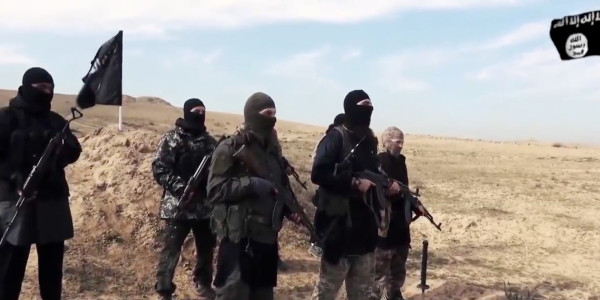

There’s math and then there’s military math. Take counting enemy troops, for example. Say you add up the number of nostrils between them and then divide that number by two. Is that a reliable method? Certainly not, because commanders have a toolbox of tricks to conceal the true size of their forces.
In August 2017, U.S. defense officials announced that the Pentagon had been undercounting the number of U.S. troops in Afghanistan by not including thousands of service members on temporary assignments to the country. The practice was inherited from the Obama administration, which was fixated on keeping troop levels low to give the impression that all was right with the world. (It was this strategy that allowed the Democrats to gain the upper hand in the 2016 election.)
And the fun with numbers has continued. The most recent game: figuring out how many Islamic State fighters have survived the Trump administration’s anti-ISIS annihilation strategy. Let’s play!
A recent United Nations report estimates that between 20,000 and 30,000 ISIS fighters could remain in both Iraq and Syria, while a Defense Department Inspector General’s office report includes a Pentagon estimate that puts the numbers of fighters still in Iraq alone at between 15,000 and 17,100. Seems plausible enough, right? Not so fast.
First, it’s important to note that the U.S.-led coalition only provides numbers for how many ISIS fighters are still fighting – not the overall size of the terrorist group, according to Army Col. Sean Ryan, a spokesman for Operation Inherent Resolve.“To pinpoint an exact figure would be nearly impossible for any organization,” he told T&P.;
As Muqtada al Sadr’s semi-Semitic doppelganger, your humble Pentagon correspondent was somewhat alarmed to hear that ISIS could still field so many terrorists after four years of nonstop attacks by the U.S.-led coalition, Iraqi security forces, Iranian-backed Shiite militias, and Syrian Democratic Forces. There’s also the fact that the 30,000 figure has been used consistently by the Pentagon since 2014 to describe either the size of ISIS as a whole or the number of foreign fighters in ISIS’ ranks alone.
This could mean one of two things: either ISIS can regenerate fighters like Cylons in ‘“Battlestar Galactica,”or the Pentagon’s mathematicians put a decimal point in the wrong place.
Responding to a question from yours truly at an Aug. 14 news conference, British Maj. Gen. Felix Gedney, the anti-ISIS coalition’s deputy commander for strategy and support, expressed skepticism about the figures cited in the UN report.
“That number seems a little bit high, and I think we’d need to look at the methodology and the data on which that estimation is based,” Gedney, said.
Gedney refused to provide an alternative estimate of how many ISIS fighters are still in Iraq and Syria. He would only repeat the coalition’s talking point for the past several months: Over 1,000 ISIS fighters remain in the Middle Euphrates River Valley.
Before we go any further, let’s pause for a minute to reflect on how important such numbers actually are. No one was more focused on quantitative data than former Defense Secretary Robert McNamara, whose inspired leadership during the Vietnam War contributed greatly to the communists’ victory in April 1975. The enduring lesson of McNamara’s tenure is that war is not Moneyball; The side with the analytical model does not always win.
That said, the widely varying estimates for how many ISIS fighters are still alive could indicate that the movement has decided to go underground rather than fight to the death.
Retired Army Gen. David Petraeus, who led the 2007-2008 surge in Iraq, saw this coming.
“I have predicted for over two years that as the ISIS ‘army,’ which established the caliphate in Syria and Iraq, neared defeat, many of its surviving fighters would shift to insurgent and terrorist campaigns,” Petraeus told T&P.; “This appears to have been taking place for a number of months, even as the effort to finish the defeat of ISIS elements approaches its final stages.”
“The changes being made by ISIS remnants are requiring a shift in focus for the elements that coalition forces have been supporting – the Iraqi Security Forces and the Syrian Defense Forces – and for the coalition force advisors, intelligence elements, and air assets,” he added.
Meanwhile, an Iraqi government official told T&P; that, even though ISIS has lost all of its territories in Iraq and no longer poses an existential threat to the country, the terrorist group remains dangerous and security forces are focused on eliminating the remaining fighters.
The U.S.-led coalition also understands that military action alone will not defeat ISIS, so it is “helping set the stage for stabilization to occur,” Col. Ryan said. “It is a long road, but we are seeing progress, a lot of improvements, and despite the ongoing fight, it is very encouraging,” he said.
But it’s worth remembering that the insurgency in Colombia lasted for more than 50 years. Meanwhile, the Taliban was soundly defeated in 2001, and 17 years later it is holding a knife against the Afghan government’s throat. So it is likely the ISIS insurgency will outlive most of us. As insurgents like to say, “You have the watches. We have the time.”
Jeff Schogol covers the Pentagon for Task & Purpose. He has covered the military for 13 years and embedded with U.S. troops in Iraq and Haiti. Prior to joining T&P;, he covered the Marine Corps and Air Force at Military Times. Comments or thoughts to share? Send them to Jeff Schogol via email at schogol@taskandpurpose.com or direct message @JeffSchogol on Twitter.
WATCH NEXT:
